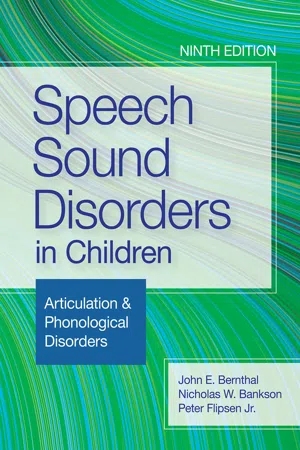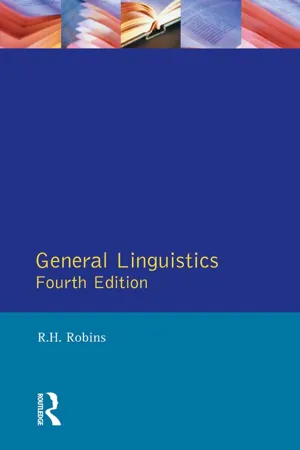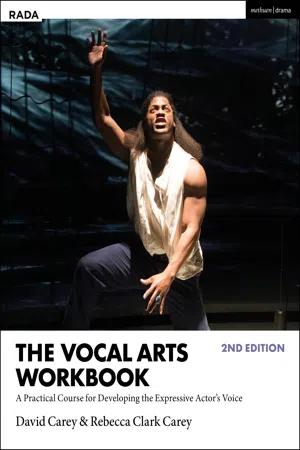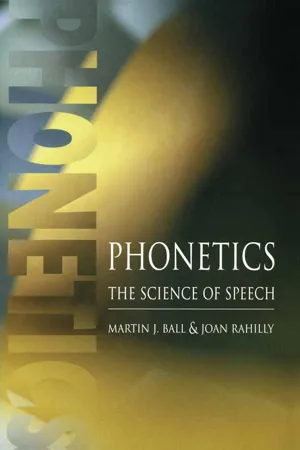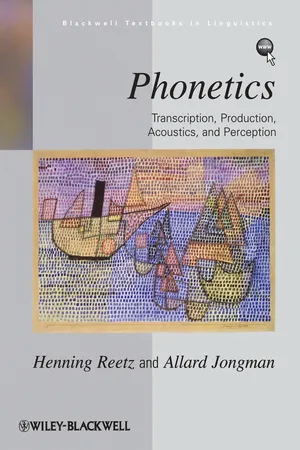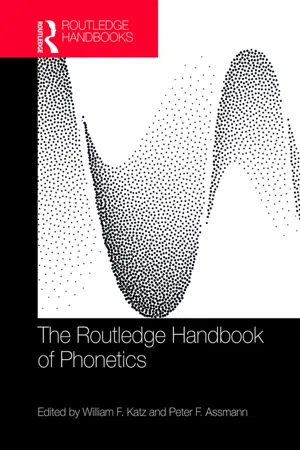Languages & Linguistics
Voice Articulation
Voice articulation refers to the production of speech sounds through the movement and positioning of the vocal organs, such as the tongue, lips, and vocal cords. It involves the precise coordination of these organs to create specific sounds and is essential for clear and effective communication in spoken language. Effective voice articulation is important for language learners and public speakers to convey their message accurately.
Written by Perlego with AI-assistance
8 Key excerpts on "Voice Articulation"
- eBook - ePub
Speech Sound Disorders in Children
Articulation & Phonological Disorders
- John E Bernthal, Nicholas W Bankson, Peter Flipsen(Authors)
- 2021(Publication Date)
- Brookes Publishing(Publisher)
2 Normal Aspects of Articulation RAY KENTLEARNING OBJECTIVESThis chapter discusses the normal aspects of speech production; that is, the way that speech is produced by individuals who do not have a communication disorder. This information is essential background to the understanding of speech sound disorders. By the end of this chapter, the reader should be able to:• Identify the basic components that are used in analyzing the structure of language.• Explain how vowel articulation is specified using both traditional phonetic description and distinctive features.• Explain how consonant articulation is specified using both traditional phonetic description and distinctive features.• Discuss what is meant by the suprasegmental features of speech.• Define coarticulation and explain why it occurs.• Discuss how aerodynamics is used to understand speech production.• Discuss how acoustic analysis is used to understand speech production.• Explain how sensory information plays a role in the production of speech.• Discuss how speech production can be analyzed in different levels of organization and information.This book is focused on the ability of humans to produce sounds that are used to convey a message. The act of producing such sounds is identified as articulation, and this activity is a major component of speech, as distinguished from the term language. Speech consists of an organized set or system of sounds that are used to convey meaning. Meaning itself is based in language, which includes the collection of words that are used in phrases and sentences, and the grammar or rules of the language that we use to create those phrases and sentences. More formally, language may be described as an arbitrary system of signs or symbols used according to prescribed rules to convey meaning within a linguistic community. Of course, once an arbitrary association of symbol with meaning has been developed, the users of that language must learn and use this association of symbols if they want to communicate with one another. The word dog - eBook - ePub
- R.H. Robins(Author)
- 2014(Publication Date)
- Routledge(Publisher)
1 respectively.From the point of view of the study of language and as part of general linguistics (which it is here considered to be), there are good reasons for prime attention being paid to articulatory phonetics. The principal parts of the body responsible for the production and differentiation of speech sounds, the vocal organs or organs of speech, are fairly easily accessible to visual observation, either directly or by means of various devices such as laryngoscopes and X-ray photography. Several of them, such as the lips, teeth, and tongue are familiar to everyone, and almost all of them can be described as far as concerns the part they play in speaking by the use of terms not difficult of comprehension to the non-specialist. The processes of speech are in the speaker's control to the extent that he can choose to speak or not to speak, and what to say in his language. Moreover, everyone has some kinaesthesis of the processes of speaking, that is to say, an awareness of some of the organs involved and of what they are doing (the widespread use of words like tongue in many languages both in the physiological and in the linguistic sense is an obvious illustration of this); and this kinaesthesis can be developed by attention, training, and practice to a considerable extent in most people and to a very marked extent in some.With this development of the awareness of the processes involved in articulation come the increasing ability to recognize and discriminate different speech sounds not forming part of one's own language (‘ear training’), and a practical control over the speech organ not merely as regards speaking one's own or a foreign language, but in the conscious control of particular organs as such in making particular movements productive of speech sounds of definite sorts. These latter skills are part of the equipment and qualification of the phonetician, or linguist who has developed this branch of the subject to a high degree of specialization. - eBook - ePub
The Vocal Arts Workbook
A Practical Course for Developing the Expressive Actor's Voice
- David Carey, Rebecca Clark Carey(Authors)
- 2021(Publication Date)
- Methuen Drama(Publisher)
5 ARTICULATION AND MUSCULARITY FrameworkSpeech is one of the most important tools we have to convey thoughts and feelings to others. Muscular articulation gives clarity and precision to speech, enabling a performer to make verbal expression more affecting and effective. If a dancer’s steps are vague or mistimed, or if a guitarist’s fingering is fumbled or misplaced, their artistic interpretation of the choreography or music is severely limited. For actors, the lips, tongue and other articulators are the equivalent of the dancer’s feet and the guitarist’s fingers: if they do not move with precision and energy, they cannot be responsive to the artistic intention.Articulation work is not the same thing as elocution, however. Making sounds with purpose and exactness is not necessarily the same thing as making sounds ‘beautifully’. Nor is it the exclusive domain of ‘classical’ performance: for example, the use of uncompromisingly muscular articulation at lightning speed in the service of complex language is a hallmark of Lin-Manuel Miranda’s Hamilton throughout the world. The aim of articulation work is simply to form all the sounds needed to make each word easily understood with an economy of effort, and to use those sounds to advance the speaker’s intention.Meeting these aims as an actor does not require that you change your accent. You may have some specific habits that are common to the region where you grew up – for example, dropping ‘t’ sounds at the ends of words, as many UK and US speakers do – which you may want to modify in certain plays and certain theatrical spaces so that you can fulfil the cadences of the text and be better understood on stage, but, in most instances, you do not have to fundamentally change the way you speak to attain effective articulation.In some cases, there may be sounds that are difficult for a person to pronounce clearly. In general, the practising of individual sounds is done in speech rather than voice classes, so this book does not address the specific formation of each English sound, nor does it give extensive drills for each one. There are many excellent resources listed in the Further reading - eBook - ePub
Understanding English Language Teaching in EFL Context
From Idea to Practicality
- Kamal Ud Din(Author)
- 2023(Publication Date)
- Routledge India(Publisher)
Victoria et al., 2005 ).6.1.2 Sounds Grouped in Terms of the Manner of Articulation
Place of articulation, as discussed above, refers to where a sound is produced and the manner of articulation refers to the way these sounds are produced, for example, whether the air is completely restricted or partially restricted. Another way the quality of sound is distinguished is by their voice (some sources consider it a separate type of articulatory phonetics but I want to include it in the ‘manner’ category for ease). It includes (1) voiced and voiceless sounds and (2) nasal and oral sounds. Let’s briefly explain each type under the articulation of consonant sounds. Manner of articulation will be briefly discussed in the following section. First consonants have been discussed followed by vowels.6.1.2.1 Articulation of Consonant Sounds
Voiced vs. voiceless sounds: To identify the voiced and voiceless sounds, we first need to understand the role of vocal cords in sound production. Vocal cords exist just above the glottis. They exist inside a circle like a door under a vault. They let air pass or stop vibrating. When air passes through them, the sound thus produced is voiceless. When the air flows freely from the glottis and travels through the cavities of the vocal tract, it touches the vocal cords. The airflow, sometimes, has to push the vocal cords (when they are not open) so that they vibrate. The sounds produced by vibration in the vocal cords are called voiced sounds. In short, the voiced sounds are produced at the throat. The voiced sound examples in English are b, d, g, and z, and the voiceless sounds are t, d, p, k, and s. Victoria et al. (2005 ) suggest that we can feel the vibration of the vocal cords by putting a finger on our ears during the production of the voiced sounds. You may check by producing both the s sound and the z sound. S is voiceless, while z - eBook - ePub
Phonetics
The Science of Speech
- Martin J Ball, Joan Rahilly(Authors)
- 2014(Publication Date)
- Routledge(Publisher)
3 Speech articulationIntroduction Consonant and vowel State of the velum Direction of airflow Force of articulation Prolongability Manner of articulation Place of articulation Three-term labelsIntroduction——————————Once an airstream has been set in motion, speech can be ‘articulated’ through the movements and settings of the supraglottal vocal organs (for example, the tongue and the lips). These settings can create long term characteristics of speech (such as voice quality), and these characteristics, together with aspects of speech controlled at the initiation and phonation stages of speech production, are termed suprasegmental aspects; we return to look at these in detail in Chapter 6 . Shorter-term aspects of speech are usually termed speech segments, and it is these that are dealt with in this and the following two chapters.At this stage, we can consider speech segments to be the individual consonants and vowels that go to make up syllables (and, of course, words). Later, in Chapter 7 , we return to this topic, and will point out that speech segments do not, in fact, have strict boundaries and to some extent merge one into another. For now, however, we adopt the usual phonetic practice of assuming that we can describe segments in a dis-crete manner. To this end, we will continue introducing the symbols of the International Phonetic Alphabet (IPA) to illustrate specific sounds: these symbols are always placed within square brackets to show they represent sounds not spellings. The entire IPA Chart is included in Appendix 1, and the most recent version described in IPA (1989, 1993, 1995, 1999). We look in more detail at transcription into phonetic symbols in Chapter 8 .It is difficult to offer a strict definition of segments simply because, as we have just noted, the features that go to make up segments (and which we are exploring in this chapter) do not all share the same boundaries. However, as Laver (1994) for example points out, we would normally expect the feature of degree of stricture (that is how close together the articulators are) to remain the same throughout a segment, even if other features (such as voicing, or lip shape - eBook - ePub
Phonetics
Transcription, Production, Acoustics, and Perception
- Henning Reetz, Allard Jongman(Authors)
- 2011(Publication Date)
- Wiley-Blackwell(Publisher)
2
Articulatory Phonetics
An important component of phonetics is the description of sounds. One mode of description is articulatory; that is, it involves an articulatory description of how speech sounds are produced. First of all, the production of any kind of sound requires a source of energy. For speech this energy source is the flow of air. For most sounds of the world’s languages, this airflow is generated by the lungs, which are described in detail in Section 5.1. Air flows from the lungs through the trachea (windpipe) and then through the larynx (voice box), where the vocal folds are located. The larynx and its role in the complex process of voice formation are discussed in detail in Section 5.2. Finally, the physiological details of the upper part of the speaking apparatus, namely the pharynx (throat), oral tract (mouth), and nasal tract (nose) are presented in Section 5.3. In this chapter, aspects of the speaking apparatus that are easy to observe will be introduced, including phonation at the larynx and articulation in the vocal tract. This description will help to explain terms used for phonetic transcription (Chapter 3).2.1 Phonation at the Larynx
The larynx (voice box) is located at the bottom of the pharynx (throat) on top of the trachea (windpipe) and consists of cartilage, muscle, ligament, and tissue. For some speakers, the larynx is visible as the Adam’s apple, moving up and down during swallowing and speaking. It is not this movement that is central for speech production but the operation of two small muscular folds inside the larynx. These are known as the vocal folds (or vocal cords) and airflow generated by the lungs must pass through them. The vocal folds can be either apart, close together, or tightly closed. When they are apart (as in normal breathing), air travels through without much obstruction. When they are tightly closed, no air passes through, which prevents, for example, food from entering the trachea. When they are close together, the airstream from the lungs will make them vibrate. This vibration is known as voicing or phonation. It is important to note that voiced sounds such as vowels and many consonants are produced with vocal fold vibration (vocal folds close together) while voiceless sounds are produced without vocal fold vibration (vocal folds apart). The presence and absence of vocal fold vibration can be determined by placing your finger loosely on your Adam’s apple and prolonging the sound at the beginning of a word likez ip(“zzzzzzzz”). This is a voiced consonant produced with vocal fold vibration and you should be able to feel this vibration with your finger. The beginning of a word like sip - eBook - ePub
- William F. Katz, Peter F. Assmann, William F. Katz, Peter F. Assmann(Authors)
- 2019(Publication Date)
- Routledge(Publisher)
Contrary to this view, laryngoscopic evidence (Esling, 1999) suggests that each state along the apparent continuum is produced by a quite distinct mechanism (Esling and Harris, 2005; Moisik and Esling, 2011), similar to those described earlier for the supralaryngeal articulators. These mechanisms may map to some degree onto the structures Edmondson and Esling (2006) term “valves.” Moisik and Gick (2017) attribute these distinct laryngeal mechanisms to the actions of different muscle groupings, each of which is built to take advantage of a stable “sweet spot” in laryngeal biomechanics: By simulating the actions of a number of these structures, they find that each generates a different reliable outcome corresponding to a different speech sound, producing such varied output states as modal voice, creaky voice, glottal stop, and aryepiglotto-epiglottal fricative. Thus, each different degree of laryngeal aperture is the output of a distinct module rather than of gradual fine adjustments in aperture, so that every laryngeal state may be viewed (both in terms of description and potential stability) as an “end state” along its own continuum. In this way, “glottal” sounds are described here in the same terms as any other laryngeal and supralaryngeal sounds. To give an example, Moisik and Gick (2017) show that the ventricular folds are involved in producing a reinforced version of a glottal stop. Rather than relying simply on the true vocal folds for the closure, the ventricular folds act as a mass that supports the closure and dampens the vibration of the true folds (like a hand resting on a handbell to stop its ringing). This view of the larynx is analogous to our earlier description of the labial sounds, which result from discrete articulatory configurations as opposed to degrees along a continuum. The physical stability of each of these states is what allows speakers to accurately produce a specific articulatory configuration time and again in rapid speech.The larynx is unlike the other structures we have observed in that it provides an exception to this “mechanical endpoint” control type when it is involved in one particular activity: inspiration. Moisik and Gick (2017) find that, unlike the vocal fold abduction that is used for speech sounds such as /h/ and plosive aspiration, the wider abduction used for inspiration operates in a variable, scalar way. That is, the more muscle activation that is used to open the vocal folds, the wider they open, in a more or less linear relationship. This flexibility in degree of glottal opening for inspiration allows the body to take in exactly as much oxygen as needed from one breath to another – an essential property for survival. The only specifically speech-related function that appears to possibly share this property of variable control is pitch (Moisik et al., 2017), though further research is needed to determine the mechanisms used by populations adept at producing a specific pitch target, such as professional singers and speakers of tone languages.Putting articulations together
The previous sections have focused on identifying the basic structures and movements that make up speech. However, describing individual movements is of course insufficient for a model of how speech works, as even the simplest utterances combine strings of multiple overlapping actions. Coarticulation – how overlapping speech movements interact with one another – must thus be a central part of a complete model of speech.Joos (1948) proposed an early embodied model of coarticulation in which he described local interactions between speech movements as the outputs of neurally mediated combinations of overlapping muscle activations. Joos argued that speech movements can be thought of as basically additive, but that the brain is needed to mediate such interactions to handle the complexity of coarticulation. The even-more-basic idea of unmediated additive muscle activations in motor control has since gained currency in the neurophysiology literature with Bizzi et al.’s. (1991) discovery of “superposition” of muscle activations in spinalized frogs. They show that overlapping movements can combine through simple addition of muscle activations, unmediated by higher structures in the nervous system. In this way, activations combine in different proportions to produce a large variety of movements. Subsequent work on humans has shown that, thus combined, only a half-dozen or so superposed modules are needed to describe a wide range of actions of the arm (D’Avella et al., 2006), the hand (Overduin, 2012), or even complex whole-body postures (Torres-Oviedo and Ting, 2007). This same mechanism has been proposed as a basis for combining speech movements in coarticulation (Gick and Stavness, 2013). - eBook - ePub
- Martin J. Ball, Nicole Muller, Ben Rutter(Authors)
- 2014(Publication Date)
- Psychology Press(Publisher)
Table 12.1 .Table 12.1 Tract Variables and ArticulatorsTract VariablesArticulatorsLP Lip protrusion Upper and lower lips, jaw LA Lip aperture Upper and lower lips, jaw TTCL Tongue tip constrict location Tongue tip, tongue body and jaw TTCD Tongue tip constrict degree Tongue tip, tongue body and jaw TBCL Tongue body constrict location Tongue body, jaw TBCD Tongue body constrict degree Tongue body, jaw VEL Constriction degree Velum GLO Constriction degree Glottis Source: Adapted from Browman & Goldstein (1992, p. 157).Gestures in articulatory phonology are defined according to their effect on a set of the tract variables in Table 12.1 . Related tract variables begin with the same letters, yielding five tract variable sets: lips, tongue tip (TT), tongue body (TB), velum (VEL), and glottis (GLO). For each tract variable set, a series of parameter values is set. For example, if a gesture involves the tongue tip (TT), we need to specify both the location of the constriction (CL) and the degree of the constriction (CD). Alternatively, if a gesture involves nasality, we need only specify the degree of constriction for the velum, as the place of constriction is self-evident.Despite the introduction of such terms as tract variable and gesture
Index pages curate the most relevant extracts from our library of academic textbooks. They’ve been created using an in-house natural language model (NLM), each adding context and meaning to key research topics.
Explore more topic indexes
Explore more topic indexes
1 of 6
Explore more topic indexes
1 of 4
